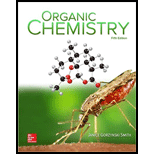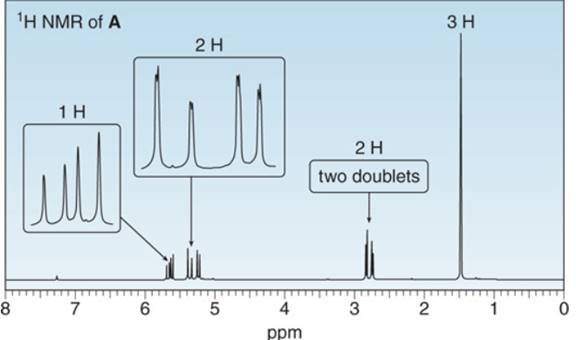
Concept explainers
The treatment of isoprene

Want to see the full answer?
Check out a sample textbook solution
Chapter 16 Solutions
Package: Organic Chemistry with Connect 2-year Access Card
- Cembrene, C20H32, is a diterpenoid hydrocarbon isolated from pine resin. Cembrene has a UV absorption at 245 nm, but dihydrocembrene (C20H34), the product of hydrogenation with 1 equivalent of H2, has no UV absorption. On exhaustive hydrogenation, 4 equivalents of H2 react, and octahydrocembrene, C20H40, is produced. On ozonolysis of cembrene, followed by treatment of the ozonide with zinc, four carbonylcontaining products are obtained: Propose a structure for cembrene that is consistent with its formation from geranylgeranyl diphosphate.arrow_forwardThe base-promoted rearrangement of an -haloketone to a carboxylic acid, known as the Favorskii rearrangement, is illustrated by the conversion of 2-chlorocyclohexanone to cyclopentanecarboxylic acid. It is proposed that NaOH first converts the a-haloketone to the substituted cyclopropanone shown in brackets and then to the sodium salt of cyclopentanecarboxylic acid. (a) Propose a mechanism for base-promoted conversion of 2-chlorocyclohexanone to the proposed intermediate. (b) Propose a mechanism for base-promoted conversion of the proposed intermediate to sodium cyclopentanecarboxylate.arrow_forwardThe formation of Br2 from NBS first involves the reaction of NBS with HBr to form an iminol intermediate and molecular bromine. The intermediate then undergoes acid-catalyzed tautomerism to form succinimide, the byproduct of the reaction. Propose a curved-arrow mechanism for the conversion of NBS into succinimide that also accounts for the formation of Br2.arrow_forward
- Aromatic substitution can be done on naphthalene. Treatment of naphthalene with concentrated H2SO4 gives two (and only two) different sulfonic acids.arrow_forwardA certain hydrocarbon, C7H10, yields the two products shown below upon oxidative cleavage with KMnO4/H3O+ . Deduce the structure of the hydrocarbon.arrow_forward1. write out all the isomers of the compound with molecular formula C4H10O. 2. select the normal/primary isomer and treat it with conc.H2SO4 and heat to produce A. Identify the type of reaction 3. Treatment of A with HCl/H2O gives B and with cold KMnO4/ OH- gives C . Give the name and structures of A, B and C 4. Treatment of A with Hot KMnO4/OH- gives D followed by acidification of the mixture to give E. What is D and E ?arrow_forward
- Addition of one mole of HCl to isoprene gives 4-chloro-2-methyl-2-butene as the major product. Propose a mechanism for this addition and account for its regioselectivity.arrow_forwardModify the structure of 3-methyl-1-pentene to show the product formed when it is reacted with: Hydrogen chloride (HCl). Show relevant stereochemistry when applicable. A dilute aqueous solution of sulfuric acid (H2SO4). Show relevant stereochemistry when applicable. Diborane (B2H6) in diglyme, followed by basic hydrogen peroxide (H2O2, OH−). Show relevant stereochemistry when applicable. Bromine (Br2) in water. Show relevant stereochemistry when applicable. Peroxyacetic acid (CH3CO3H). Do not include stereochemistry.arrow_forwardA solution of acetone [(CH3)2C=O] in ethanol (CH3CH2OH) in the presence of a trace of acid was allowed to stand for several days, and a new compound of molecular formula C7H16O2 was formed. The IR spectrum showed only one major peak in the functional group region around 3000 cm−1, and the 1H NMR spectrum is given here. What is the structure of the product?arrow_forward
- 1.Describe the ozonolysis of alkenes 2.one mole of a hydrocarbon(A) reacts with one mole of beomine giving a dibromo compound C5H10Br2.Substance A on treatment with cold dilute kMnO4 solution forms a compound C5C12O2(C5H12O2) on ozonolysis A,gives equimolar quantities of propanone and ethanol.Deduce the structure of substance A.arrow_forwardWhich of the following statements is correct? A) The haloform reaction proceeds under very difficult conditions and the yield is very low. B) The haloform reaction is used only for the identification of compounds containing secondary alcohol groups. C) Methyl ketones or alcohols are oxidized with halogens in acidic solutions to give carboxylic acids and the appropriate haloform product. D) Enolate anions react rapidly with halogens to give alpha-halocarbonyl compounds.arrow_forwarda. Compound X is benzene, Y is acetic anhydride acid. Complete the following scheme and determine Z! b. Determine which reagents except acetic acid anhydrides can replace Y!arrow_forward

 Organic ChemistryChemistryISBN:9781305580350Author:William H. Brown, Brent L. Iverson, Eric Anslyn, Christopher S. FootePublisher:Cengage Learning
Organic ChemistryChemistryISBN:9781305580350Author:William H. Brown, Brent L. Iverson, Eric Anslyn, Christopher S. FootePublisher:Cengage Learning

